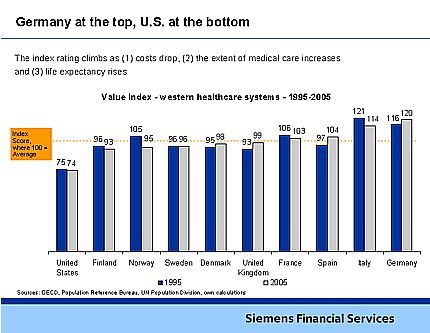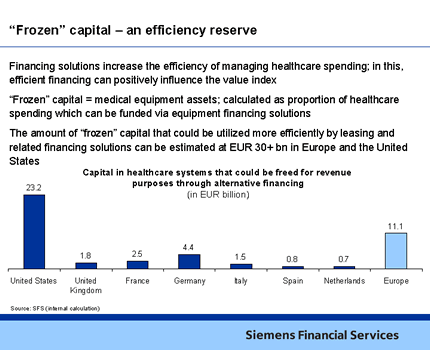| Policy | |
Disparity in efficiency of healthcare financing in western countries13 July 2006. Francais Espanol Munich, Germany. A new research paper from Siemens Financial Services, entitled Healthcare Affordability — The Global Challenge highlights the need for efficient use of capital in Western healthcare systems. In order to make the wide range of existing systems comparable, the paper also calls for a simple method of measuring value for money from national healthcare regimes in Europe and the US. The paper has created a very basic starting-point. It suggests that Germany’s healthcare system offers a comparably good return on investment in relation to other key European countries’ and the US’ healthcare systems — in terms of basic healthcare provision, life expectancy and cost. Moreover, the paper focuses attention on technology and equipment finance as an area which can be made more financially efficient in the short term. It also shows the amount of capital that is 'frozen' in the system when equipment is bought outright rather than leased, hired or otherwise financed. The equivalent amount of this 'frozen' capital is estimated to be over €10 billion in the main European economies and some €20 billion or more in the US. The authors especially suggest extended use of tailor-made leasing and other forms of equipment financing solutions to meet technological, financial and medical requirements. Following the ground-breaking efforts by the World Health Organisation to create a global measurement model in 2000, the research study analyses the state of healthcare funding in the US, the UK, France, Germany Italy, Spain and Scandinavia. It notes that the US spends most on healthcare out of all the countries studied, but — according to a rough prototype metric constructed by the authors of the paper — delivers the least value in terms of healthcare provision and life expectancy. This contrasts with Germany’s healthcare system which has recently been subjected to strict financial controls while is still able to ensure a high quality service.
The authors
therefore raise the issue of efficient use of capital in Western world
healthcare systems. The paper estimates the amount of capital that is
'frozen' in the system when equipment is bought outright rather than leased,
hired or otherwise financed. Across all the healthcare systems studied, this
'frozen' capital currently can be estimated at over
€30 billion annually.
Methodology: The study is based on broad range of public and non-public sources and a multitude of qualified interviews with experts of Siemens Financial Services and Siemens Medical Solutions regarding global trends in healthcare system and financing solutions. Download research paper as PDF from the Siemens
website:
|

